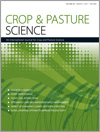BioOne.org will be down briefly for maintenance on 14 May 2025 between 18:00-22:00 Pacific Time US. We apologize for any inconvenience.

Alternate furrow irrigation affects yield and water-use efficiency of maize under deficit irrigation
No abstract available
